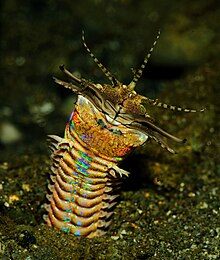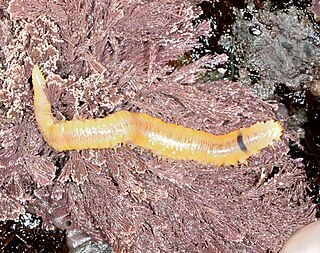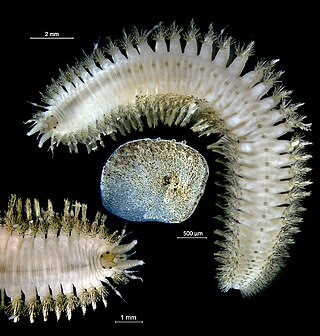| Eunicida Temporal range: | |
|---|---|
 | |
| Eunice aphroditois | |
| Scientific classification | |
| Domain: | Eukaryota |
| Kingdom: | Animalia |
| Phylum: | Annelida |
| Class: | Polychaeta |
| Order: | Eunicida [1] |
| Families | |
Eunicida is an order of polychaete worms.
| Eunicida Temporal range: | |
|---|---|
 | |
| Eunice aphroditois | |
| Scientific classification | |
| Domain: | Eukaryota |
| Kingdom: | Animalia |
| Phylum: | Annelida |
| Class: | Polychaeta |
| Order: | Eunicida [1] |
| Families | |
Eunicida is an order of polychaete worms.
Members of this order have an elongated, segmented body and a distinct head, normally with a separate peristomium and prostomium. Many, but not all, live in tubes which vary from a mucous sheath to a tough, horny casing. The palps vary from globular to cylindrical and there are from 0 to 7 antennae, usually smooth but occasionally jointed. There is a muscular pharynx with a dorsal pair of mandibles and a set of ventral, toothed, maxillary plates. Some species have tentacular cirri and all have unbranched parapodia. In some species, dorsal cirri, branchiae, ventral cirri and chaetae occur, but not in others. [2]
The Devonian Websteroprion is the largest known fossil eunicidan annelid, with estimated length 1–2 m (3 ft 3 in – 6 ft 7 in). [3] It also had the biggest scolecodonts of any prehistoric polychaete, up to 13.2 mm (0.52 in) in length and possibly larger. [3]
The World Register of Marine Species (WoRMS) includes the following families in the order: [1]

Polychaeta is a paraphyletic class of generally marine annelid worms, commonly called bristle worms or polychaetes. Each body segment has a pair of fleshy protrusions called parapodia that bear many bristles, called chaetae, which are made of chitin. More than 10,000 species are described in this class. Common representatives include the lugworm and the sandworm or clam worm Alitta.

In invertebrates, the term parapodium refers to lateral outgrowths or protrusions from the body. Parapodia are predominantly found in annelids, where they are paired, unjointed lateral outgrowths that bear the chaetae. In several groups of sea snails and sea slugs, 'parapodium' refers to lateral fleshy protrusions.

Haplodrili, or Archiannelida, is an order of primitive polychaete worms. Zoologist Ray Lankester gave it the name haplodrili, while zoologist Berthold Hatschek later named it Archiannelida. Once considered to be a class under Annelida, and even a separate phylum, Haplodrili is now widely accepted to be an order under Polychaeta. Species in this order are known for completely lacking external segments.

Phyllodocida is an order of polychaete worms in the subclass Aciculata. These worms are mostly marine, though some are found in brackish water. Most are active benthic creatures, moving over the surface or burrowing in sediments, or living in cracks and crevices in bedrock. A few construct tubes in which they live and some are pelagic, swimming through the water column. There are estimated to be more than 4,600 accepted species in the order.
The Onuphidae are a family of polychaete worms.
Haplosyllis spongicola, the sponge worm, is a species of polychaete worm in the family Syllidae. It was previously classified as Syllis spongicola and is part of a species complex of closely related species that are difficult to distinguish morphologically and where the demarcation between them is unclear. It is found in shallow temperate, subtropical and tropical seas worldwide, wherever its host sponges are found.

Eulalia viridis is a species of bright-green polychaete worm in the family Phyllodocidae. It can range from 5 to 15 cm in length and is usually found in shallow north Atlantic water under rocks or in mussel beds.
In biology, a cirrusSIRR-əs, PL: cirri, SIRR-eye, is a long, thin structure in an animal similar to a tentacle but generally lacking the tentacle's strength, flexibility, thickness, and sensitivity.
Ophryotrocha craigsmithi is a species of polychaete worm. O. craigsmithi is named after Craig R. Smith. This species is similar to Palpiphitime lipovskyae and O. Platykephale, among others, in having branchial structures dorsally and ventrally. It differs from O. platykephale in the shape of its prostomium and parapodia. Palpiphitime lipovskyae has jaws of both P- and K-type, while no specimens of O. craigsmithi have been found with K-type jaws thus far. Ophryotrocha craigsmithi differs from P. lipovskyae genetically, but also by the presence of a prominent ventral chaetal lobe with a bulging simple chaeta in the former.
Nereis onychophora is a polychaete worm of the phylum Annelida. The type locality is in the Seram Sea, Indonesia.

Phyllodoce mucosa is a species of polychaete worm in the family Phyllodocidae. It is found intertidally in both the Pacific and Atlantic Oceans, typically on sandy or muddy seabeds.

Phyllodocidae is a family of polychaete worms. Worms in this family live on the seabed and may burrow under the sediment.
Eulalia clavigera is a species of polychaete worm in the family Phyllodocidae, native to the coasts around Britain, through Western France, and to the Iberian Peninsula. It closely resembles Eulalia viridis, and there has been confusion in the past as to the identification of the two species.

Ramisyllis multicaudata is a species of polychaete worm in the family Syllidae. It was found in Darwin Harbour, Australia, where it was living within the tissues of a sponge of the genus Petrosia. It was the second branching species of polychaete worm to have been discovered, the first having been Syllis ramosa, a deep water species, more than a century earlier. In 2022, a second species in R. multicaudata's genus, Ramisyllis kingghidorahi, was described from specimens taken off the coast of Sado Island, Japan.

Arctonoe vittata is a species of scaled polychaete worms commonly known as a "scale worm". This species often lives as a commensal of another marine animal.

Lepidonotus squamatus is a species of polychaete worm, commonly known as a "scale worm", in the family Polynoidae. This species occurs in both the Atlantic and the Pacific Oceans. It was first described by the Swedish naturalist Carl Linnaeus in 1758 as Aphrodita squamata but was later transferred to the genus Lepidonotus.

Leucia is a genus of marine polychaete worms belonging to the family Polynoidae, the scaleworms. Leucia contains 2 species, both found in the northern Atlantic Ocean. This genus is distinguished from the closely related genus Harmothoe by having sixteen pairs of elytra, as opposed to fifteen.

Leucia nivea is a species of polychaete worm, commonly known as a "scale worm", in the family Polynoidae. This species occurs in the northeastern Atlantic Ocean, the North Sea and the Mediterranean Sea.

Poecilochaetus serpens is a species of marine polychaete worm in the family Poecilochaetidae. It is a benthic worm that burrows into soft sediment.

Websteroprion is a genus of eunicidan polychaete that lived during the middle Devonian period in what is now Canada. It contains a single species, W. armstrongi, recovered from the Kwataboahegan Formation.